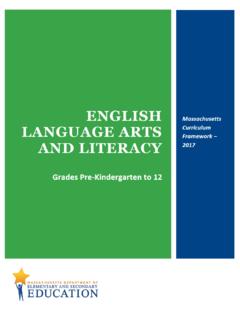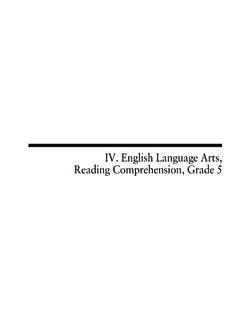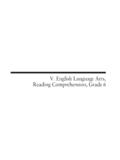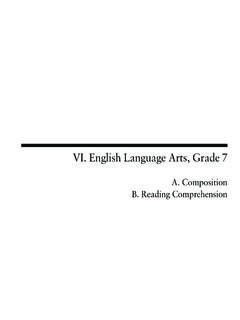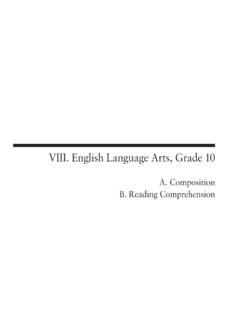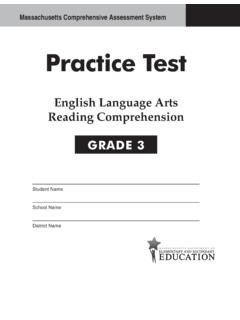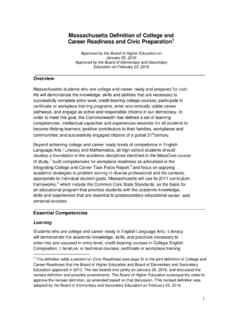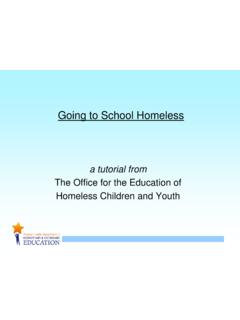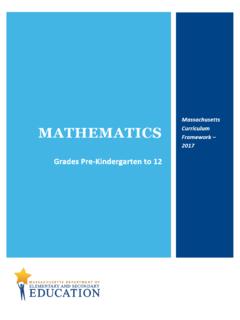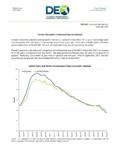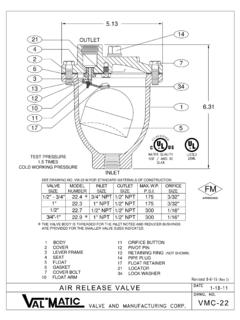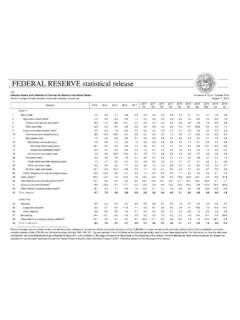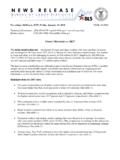Transcription of VII. English Language Arts, Reading …
1 VII. English Language arts , Reading Comprehension, Grade 897 Grade 8 english language arts Reading Comprehension Test The spring 2013 grade 8 english language arts Reading Comprehension test was based on grades 6 12 learning standards in two content strands of the Massachusetts Curriculum Framework for English Language arts and Literacy (March 2011) listed below. Page numbers for the learning standards appear in parentheses. Reading (Framework, pages 47 52) Language (Framework, pages 64 67)The Curriculum Framework for English Language arts and Literacy is available on the Department website at Reading Comprehension test results are reported under two MCAS reporting categories, Reading and Language , which are identical to the two framework content strands listed Sessions and Content OverviewThe grade 8 ELA Reading Comprehension test included two separate test sessions. Each session included Reading passages, followed by multiple-choice and open-response questions.
2 Selected common Reading passages and approximately half of the common test items are shown on the following pages as they appeared in test booklets. Reference MaterialsThe use of bilingual word-to-word dictionaries was allowed for current and former English Language learner students only, during both ELA Reading Comprehension sessions. No other reference materials were allowed during any ELA Reading Comprehension test session. Cross-Reference InformationThe tables at the conclusion of this chapter indicate each released and unreleased common item s reporting category and the standard it assesses. The correct answers for released multiple-choice questions are also displayed in the released item Language ArtsReading CompRehensionDIRECTIONSThis session contains two Reading selections with seventeen multiple-choice questions and two open-response questions. Mark your answers to these questions in the spaces provided in your Student Answer this article and answer the questions that From the tombby Moonsil Lee Kim1 marquis a royal title 1 oday, Chinese food is well known around the world, and recipes for Chinese cooking can be found in most cookbooks and on many Web sites.
3 While books with some information about ancient Chinese food have survived the centuries, fascinating new information has come more recently from tombs. Save the broken bamboo StripS! 2 In 1999, a tomb belonging to Wu Yang, the marquis1 of Yuanling, who lived during the Han dynasty and died in 162 , was discovered at the site of Huxishan. In his tomb was a book made of 300 bamboo strips, every one of which was found broken. Yet, after much painstaking work, conservators were able to reassemble many of the erased and mixed-up fragments. Further study allowed researchers to determine that it was actually a cookbook titled Meishifang ( Recipes for Beautiful Food ). It seems that each recipe had a title preceded by a number. In turn, each title began with the phrase recipe to For example, one began recipe to make slabs of suckling pig. Unfortunately, many titles are illegible; so, too, are some of the numbers. Today, work continues on reconstructing and interpreting these texts.
4 3 Perhaps those who buried the cookbook with the marquis of Yuanling s remains expected that it would be used by his servants when they prepared food for him in the afterlife. The recipe ingredients could have been those he enjoyed most when he was alive or perhaps they were the sacred, ideal foods for the afterlife. In any case, the Meishifang shows that Han elite enjoyed a varied diet that included vegetables and meats such as pig, chicken, dog, lamb, goose, deer, swallow, beef, and hare. The recipes also offer evidence that the Chinese at the time used a variety of cooking techniques. Among these were steaming, braising, and stewing in liquor with ginger and various other ingredients for flavoring. tnumber 46: recipe to make SlabS oF Suckling pigFirst butcher the pig, then singe and scrape away the hair. Use the edge of the hand with the fingers moving away from Reading Comprehension thiS lady had it all!4 Another tomb that allows us to glimpse ancient cooking practices is Han tomb No.
5 1 at Mawangdui. It belonged to the wife of the marquis of Dai, who died around 168 this tomb, there was a lacquered2 tray that could hold a single meal for Lady Dai, exactly as she had been accustomed to eating when she was alive. The five small bowls on the tray contained meat dishes. Also buried with her in the tomb were bamboo cases and pottery vessels that held a great variety of foods. These were to nourish her on the long journey in the afterworld. There were seven kinds of grains and beans, five kinds of fruits (melon, jujube, pear, plum, and strawberry), five kinds of vegetables (malva, mustard, ginger, lotus root, and hemp), five mammal meats (hare, dog, deer, ox, and sheep), 13 bird meats and eggs (duck, chicken, pheasant, crane, pigeon, owl, magpie, sparrow, and others), six kinds of fish (carp, bream, catfish, perch, and others), and several spices and medicinal herbs. These foodstuffs show the variety of ingredients used for cooking in ancient China. What the dead eat 5 In addition to these written records and preserved foods, there is another type of recipe in these tombs mural paintings and relief 3 carvings depicting cooking scenes.
6 The ancient Chinese believed that such images were real and had the power to nourish the deceased in the afterlife. These images show various types of meat, cooking utensils, including large cauldrons, and people preparing food. Some people are butchering animals, while others are stirring food in boiling pots, cutting ingredients, and carrying items to cook. 6 Mural paintings and relief carvings are very informative, as they not only represent kitchen activities, but also explain the process for making food. For example, a series of images was found engraved on a stone slab on a wall in a Han tomb discovered at Dahuting. After much analysis and discussion, scholars determined that the relief (illustration below) describes the process of making tofu: [number unknoWn]: [title unknoWn]..boil. When done, lift it out and discard the broth. Take the fresh sweet fresh broth and add wine, salt, meat sauce liquid, ginger, and magnolia. Boil it again. When done, lift it out and serve.
7 The recipe for making boiled horse, boiled lamb, and boiled deer is like procedure for making tofu1) soaking soybeans, 2) grinding soybeans, 3) filtering the soymilk, 4) adding brine, and 5) pressing for solidification and dewatering. This 2 lacquered covered with a clear, glossy protective coating 3 relief a flat art form that contains three-dimensional elements100 ELA Reading Comprehension process matches almost exactly the recipe for making tofu in a medieval Chinese cookbook. Moreover, we can see that the same recipe and the utensils, including the millstone and the pressing box shown at the end of the process, are still being used today in the countryside in China. a tradition that endureS 7 These tomb recipes clearly show that many of the foods and methods of preparation found in Chinese kitchens today trace their origins to those living in China more than 2,000 years ago. But, it is not just in China where 21st-century diners will find these foods. Many restaurants in the United States, and indeed around the world, offer them as well.
8 Food from the Tomb by Moonsil Lee Kim, from Dig, November/December 2009. Text and illustrations copyright 2009 by Carus Publishing Company. Reprinted by permission of Cobblestone :297280 C Common 1 How does the author introduce the topic in paragraph 1?A. by outlining the steps in a processB. by revealing a personal interest in the subjectC. by narrowing the focus from general to specificD. by making a humorous statement about the subjectID:297283 A Common 2 In paragraph 2, Yet, In turn, and Today are examples ofA. transition topic supporting concluding Reading Comprehension ID:297318 B Common 3 According to the article, which conclusion is best supported by discoveries made in the tombs of Wu Yang and Lady Dai?A. The wealthy made their own The wealthy ate an assortment of The wealthy painted the murals in their The wealthy were buried with few :297302 D Common 4 In paragraph 5, the quotation marks surrounding recipe mainly indicateA.
9 A word used in an opinion of the a term used by many an uncommon meaning of the :297314 B Common 5 What is the main purpose of paragraph 7?A. to suggest further researchB. to connect past and presentC. to offer advice to the readerD. to separate truth from folkloreID:297321 C Common 6 If the author were to provide more information about artwork found in tombs, it would most likely appear in which of the following sections?A. Save the Broken Bamboo Strips! B. This Lady Had It All! C. What the Dead Eat D. A Tradition That Endures ID:297326 B Common 7 The Latin word conserv are means to save or to protect. In paragraph 2, a conservator is someone whoA. defends preserves works at a collects pieces of Reading Comprehension ID:297338 Common 8 Based on the article, explain how the author shows that food was important to the ancient Chinese people s beliefs about the afterlife. Support your answer with relevant and specific details from the 8 is an open-response question.
10 Read the question carefully. Explain your answer. Add supporting details. Double-check your your answer to question 8 in the space provided in your Student Answer Reading Comprehension from Tamarby Mal Peet 1 He loved her. It was dead simple, the way he loved her. Seamless. His love was like a wall that he d built around her, and there wasn t a chink or flaw in it. Or so he thought. But then she started to float out of the real world, his world, and he was like a little boy trying to dam a stream with stones and mud, knowing that the water would always break through at a place he wasn t looking at. There was nothing desperate about the way he did it, though. He was always calm, it seemed. Expecting the worst and determined not to crack. She started to get up in the night and turn on all the taps, and he would get up too and stand quietly beside her watching the endless flow of water as if he found it as fascinating as she did. Then he d guide her back to bed before turning the taps off.
